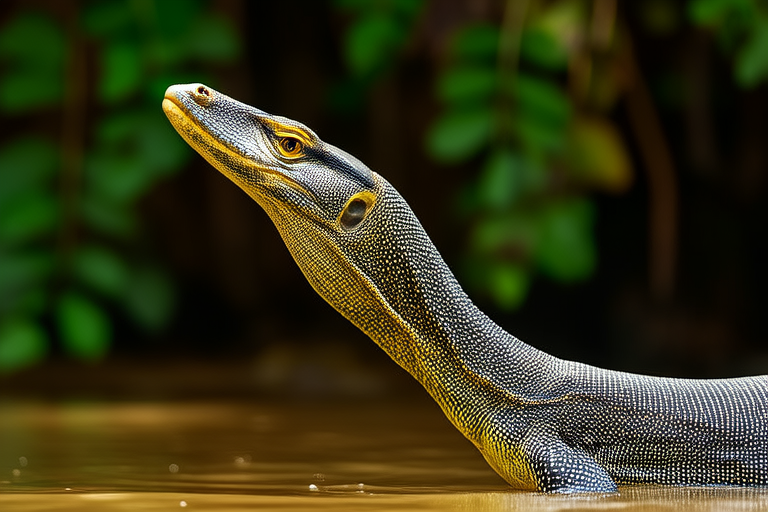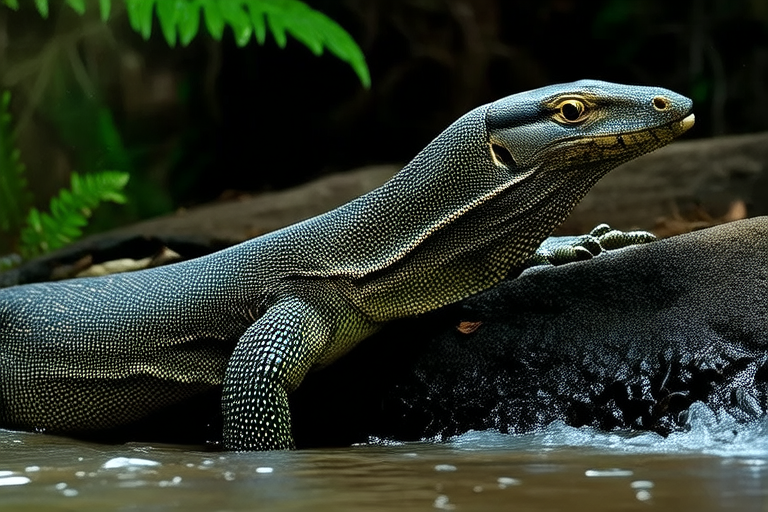
Top 10 Fascinating Facts About Water Monitors You Need to Know
The water monitor (Varanus salvator) is one of the most impressive reptiles on Earth, renowned for its remarkable adaptability and fascinating behaviors. Found across Southeast Asia, these lizards are known for their size, intelligence, and diverse hunting tactics. From their aquatic prowess to their complex social structures, there’s much to learn about these creatures. Here are ten captivating facts that will deepen your appreciation for the water monitor.
1. The Largest Lizard on Earth
Water monitors are among the largest lizards in the world, with males often reaching lengths of up to 3 meters (9.8 feet) and weighing over 50 kilograms (110 pounds). Females are typically smaller, but both sexes can grow to substantial sizes. Their elongated bodies, powerful limbs, and sharp claws make them formidable predators and agile climbers. A recent study published in the Journal of Herpetology highlights how their size allows them to take down larger prey, including small mammals and birds.
2. Versatile Diet
Water monitors are opportunistic omnivores, meaning they eat a wide variety of foods. Their diet includes insects, fish, frogs, birds, eggs, and even carrion. They have been observed eating fruit, which suggests they may play a role in seed dispersal within their ecosystem. This adaptability helps them thrive in diverse environments, from dense forests to coastal mangroves. Their strong jaws and teeth enable them to crush shells and bones, making them efficient scavengers as well as active hunters.
3. Aquatic Abilities
These lizards are adept swimmers, capable of diving to depths of several meters and staying submerged for up to 30 minutes. Their streamlined bodies and muscular tails assist in propelling them through water, while their nostrils and eyes are positioned high on their heads, allowing them to breathe and see while partially submerged. Studies conducted by the University of California, Berkeley, have shown that water monitors can dive to catch fish, an ability that sets them apart from many other lizard species.
4. Long Lifespan
Water monitors can live for up to 20 years in the wild, though their lifespan is shorter in captivity due to various factors such as stress and disease. In optimal conditions, they can reach advanced ages, making them one of the longest-lived reptiles. Their longevity is attributed to their robust immune systems and efficient metabolism, which help them resist diseases and recover from injuries.
5. Hunting Techniques
Water monitors are skilled hunters, employing a combination of stealth and speed to catch their prey. They can ambush unsuspecting animals from trees or rocks, using their keen sense of smell to track potential victims. Once they spot a target, they pounce with incredible agility, often catching their prey off guard. Their powerful jaws and sharp claws allow them to subdue even large animals. Recent research has also indicated that water monitors can use tools, such as sticks, to probe holes and extract hidden prey.
6. Complex Communication
Water monitors communicate through a range of vocalizations, body postures, and chemical signals. They emit low-frequency sounds when threatened or during mating rituals, which can travel long distances underwater. Additionally, they use pheromones to mark territories and attract mates. These sophisticated communication methods highlight the intelligence and social complexity of water monitors, suggesting they may possess more advanced cognitive abilities than previously thought.
7. Intelligence and Problem-Solving Skills
Water monitors exhibit high levels of intelligence and problem-solving capabilities. They have been observed opening cage doors and solving puzzles to access food, demonstrating their ability to think critically and adapt to new situations. Their cognitive skills are comparable to those of some primates, making them one of the most intelligent reptile species. Scientists at the University of Melbourne have conducted experiments showing that water monitors can remember solutions to problems for extended periods, indicating a level of memory retention rarely seen in reptiles.
8. Habitat Adaptation
Water monitors are highly adaptable to different habitats, thriving in a range of environments from tropical rainforests to mangrove swamps. They are equally comfortable on land, in trees, and in water, which contributes to their widespread distribution across Southeast Asia. Their ability to adjust to changing conditions, including temperature and humidity, allows them to survive in areas where other species might struggle. This adaptability is a key factor in their success as a species.
9. Unique Survival Strategies
In addition to their physical attributes, water monitors employ unique survival strategies to avoid predators and secure resources. They are known to bury themselves in mud or sand during hot weather, emerging only when conditions improve. This behavior not only protects them from extreme temperatures but also helps them conserve energy. Furthermore, they are adept at camouflage, blending into their surroundings to avoid detection by both predators and prey.
10. Social Structure
Contrary to popular belief, water monitors are not entirely solitary animals. They exhibit complex social behaviors, including cooperative hunting and communal nesting. Males often establish dominance hierarchies, with dominant individuals having access to better territories and mating opportunities. Females may gather in groups to lay their eggs in communal nests, ensuring better protection for their offspring. Observations in the field have revealed that water monitors can recognize individual members of their group and respond differently to familiar versus unfamiliar conspecifics.
In conclusion, water monitors are fascinating creatures that continue to surprise researchers with their intelligence, adaptability, and unique behaviors. Whether you’re a seasoned herpetologist or simply curious about the natural world, learning about these magnificent lizards offers a deeper understanding of the diversity and complexity of life on Earth.




